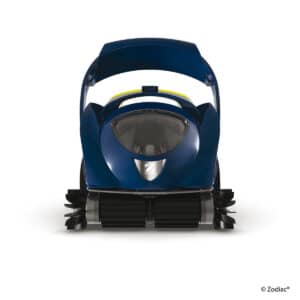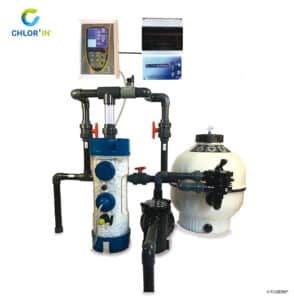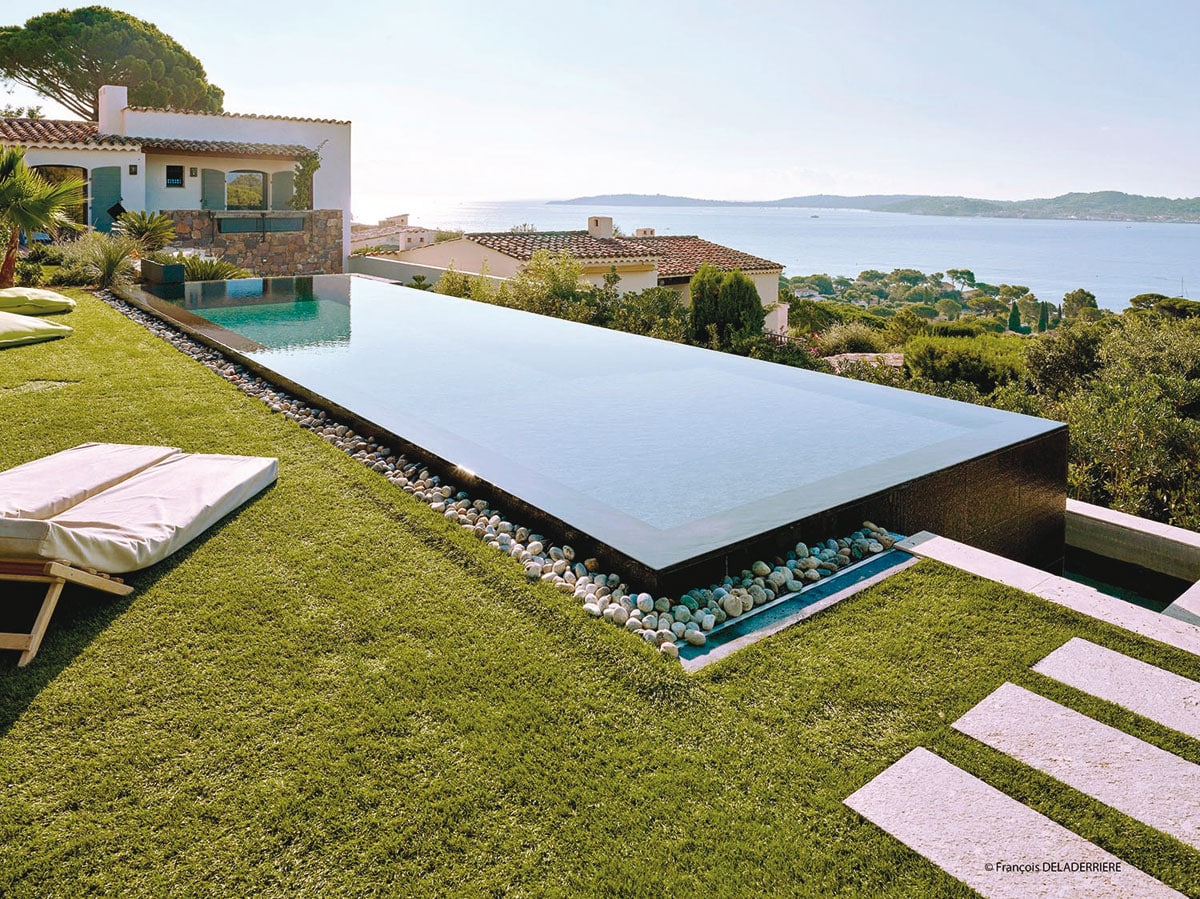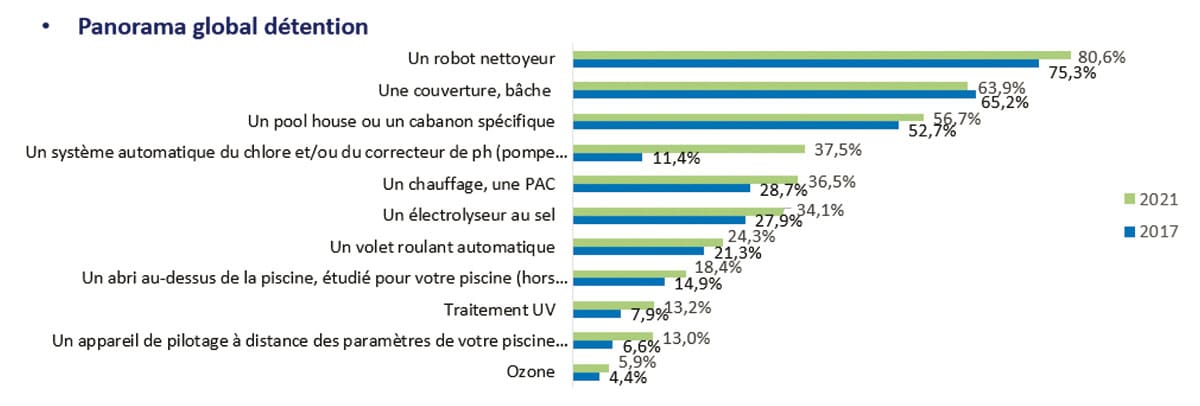 France now has 3,2 million swimming pools. In ten years, the park has been multiplied by almost two! Just in Reunion, some 800 swimming pools are built each year! The confinements accelerated the phenomenon and, after Covid, which led to two years of euphoria on the market, the professionals decided to take stock, notably by commissioning an exclusive consumer survey. The observation is clear : supported by a search for well-being in accordance with environmental and societal requirements, the market has good prospects. The latest innovations and new products were exhibited during the Piscine Global Europe exhibition from November 15 to 18 at Eurexpo Lyon.
France now has 3,2 million swimming pools. In ten years, the park has been multiplied by almost two! Just in Reunion, some 800 swimming pools are built each year! The confinements accelerated the phenomenon and, after Covid, which led to two years of euphoria on the market, the professionals decided to take stock, notably by commissioning an exclusive consumer survey. The observation is clear : supported by a search for well-being in accordance with environmental and societal requirements, the market has good prospects. The latest innovations and new products were exhibited during the Piscine Global Europe exhibition from November 15 to 18 at Eurexpo Lyon.
According to 2021 figures from the Federation of Pool and Spa Professionals (FPP), the French swimming pool stock is made up almost equally of in-ground swimming pools (1,55 million pools) and above ground swimming pools (1,64 million). The year 2021 saw the construction of nearly 86,000 in-ground swimming pools and 158,000 above-ground swimming pools., i.e. 244,000 new pools installed in one year. Democratized, the swimming pool has today become a facility that concerns all categories of the population. According to the results of the Décryptis study for FPP, the share of employees, workers, farmers among swimming pool owners has jumped by almost nine points in just four years! They represented 23% of in-ground pool owners in 2021 (14% in 2017). The share of entrepreneurs and executives (artisans, tradespeople, business owners, senior executives, liberal professions) remained stable at 47% (43% in 2017). Retirees are now less represented in proportion among owners of in-ground swimming pools at home : 30% in 2021 compared to 40% in 2017. With an increasingly diversified profile of swimming pool owners, the market outlook looks promising : 400,000 French people have already decided to equip themselves by the end of 2024 and 300,000 plan to renovate their pools.
Spa sales are also on the rise. They reached a record number of 5,700 new spas at the end of 2021. (+ 63% in four years).
Nearly four billion euros in turnover
The French swimming pool sector brings together 3,640 companies, including 3,300 for swimming pool sales activities and 340 for the manufacturing and distribution of equipment (source : economic assessment of the swimming pool market in France at the end of 2021, FPP — Xerfi Specific). The majority of swimming pool sales specialists (61 %) take charge of all projects, from sale to installation of the pool, through the execution of the structural work. The turnover of the sector was approaching, in total, 4 billion euros, almost twice as much as in 2017.
Dont 2,2 billion (56 %) come from the sale of swimming pools and services and 1,7 billion from the sale of products and equipment. French expertise in swimming pools is also recognized internationally : in 2021, manufacturers and distributors of swimming pool equipment achieved 225 million export turnover (+ 39% over one year).

Companies in the swimming pool sector have recruited 4,000 new employees to strengthen their teams in 2021. Collaborators mainly in fact. The sector remains poorly feminized : in four years, the share of female jobs increased by only three percent (26% women in 2021, 23% in 2017). The sector nonetheless represents 60,000 direct and indirect jobs today., and 42% of swimming pool sales companies say they still need to recruit. Another sign of dynamism : 58% of companies say they are ready to train young people ; 2,100 contracts are thus open to them, whether alternating, learning, qualification or professionalization. There is a specific professional certificate for swimming pool professions. In France, eleven establishments train students for this diploma in two years. Once obtained, it opens the doors to employment : 90% of new graduates are hired within three months.
Responsible professionals
The French trust swimming pool professionals who compete in skills and imagination to offer swimming pools in line with consumer desires and societal expectations..
Building a swimming pool requires a high level of expertise in many areas. Budget, model, shape, emplacement, landscape integration, pool color, filtration system, security device : all these parameters must be studied. Nearly two-thirds of households have swimming pools (65,8 %) entrusted the entire construction of their in-ground swimming pool to a professional. They are even almost eight out of ten (77,4 %) if we also take into account those who benefited from support during the installation of their swimming pool kit. Only 22,6% completely installed their pool without any help from a professional. Seven out of ten of the 400,000 households intending to install a swimming pool by the end of 2024 are considering seeking professional support to make their project a reality..

Taking into account societal expectations by professionals takes several forms. Swimming pools fit into smaller gardens. More than a third of in-ground swimming pools (35 %) is built in gardens less than or equal to 700 m2. The size of in-ground swimming pools has also decreased, going from 41,7 m2 on average for in-ground swimming pools built before 1991 to 29 m2 for swimming pools built from 2019. Professionals are also responding to increased demand for equipment. Shelters, which allow the swimming season to be extended, experienced a record number of installations in 2021.

Professionals also work alongside users to support them in the controlled management of swimming pools in order to limit their environmental footprint.. With its approximately 1,400 members, the FPP initiated the European environmental standard for the sector which has just been finalized. It will provide consumers with information on the energy efficiency linked to the operation of each of the pieces of equipment making up a swimming pool., and for the swimming pool as a whole. Thanks to a repository of pictograms, swimming pool professionals and consumers will have an overview of the environmental performance of different equipment and products. Published in August 2022, this standard will gradually come into application from 2023. The Federation is currently working on the development of a guide to support professionals in its implementation.

Professionals advise on good practices to adopt in order to reduce the use of water in swimming pools. for example, a swimming pool does not empty every year : the renewal of a third of the water in the basin is more than sufficient. Protecting the pool with a cover limits external pollution as well as water evaporation. The filtering process must be appropriate and well sized for the type and size of the pool. Or the rain is the swimming pool’s ally : the rainfall makes it possible to provide part of the water supply necessary for annual renewal. In France, a swimming pool receives between 60 cm and 120 cm of rainwater each year. The swimming pool becomes a water recovery reservoir and acts as a buffer during violent and devastating storms..
Swimming pools becoming more and more ecological

This drastic decrease is due to the action of two factors : the reduction of pond volumes and the arrival of more efficient filtration techniques associated with good water circulation. The use of water from family swimming pools today represents a small share of annual water use in France : 0,11% for the total number of swimming pools and 0,02% for filling new basins. Water consumption of all swimming pools in France, or more than three million in 2021, would represent 0,1% of the country’s overall water consumption.

Here again, technological advances and improvements in swimming pool equipment have made it possible to reduce energy consumption linked to swimming pools. Filtration systems consume 6,5 times less energy, and lighting consumes almost 40 times less energy than forty years ago. Consumption of heating systems (heat pump) was divided by 9,5 over the same period.
Reasonable water treatment
The water treatment products are the same as those used for the urban drinking water network and each has a European standard.. Today, 80% of water quality comes from filtration and 20% from the use of treatment products 
to 0,5 mg/l in the distribution circuits of water for human consumption. Alternative solutions for chlorine in tablets have emerged, such as salt electrolysis treatment., ozone ou UV. Salt electrolysis especially : today 28% of the swimming pools are equipped with them. Nearly one in two swimming pools is sold with this treatment.
Recycling swimming pool materials
In 2020, the FPP carried out a study on the methods of managing swimming pool waste with its members.. Nearly 60% of this waste is recycled, 30% is eliminated or recovered for energy and 10% is reused. However, logistical recovery and recycling solutions still do not exist throughout the country for certain materials., like PVC liners (which are changed every 10 to 15 years) and the armed membranes, polyester and other plastic hulls.
THE PROPISCINES LABEL
The FPP Propiscines Label, which is celebrating its 10th anniversary this year, has integrated the environment and water management into its charter since its beginnings. It includes five chapters : information et service client, The respect of the rules, quality of products and services, safety and preservation of the environment. In 2022, the FPP reinforces the environmental commitment obligation of the charter. Today, 556 professionals are involved in this process.


















